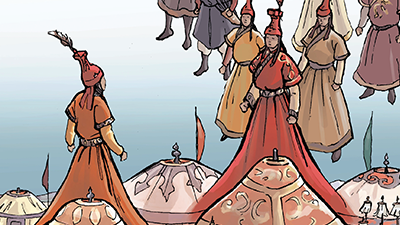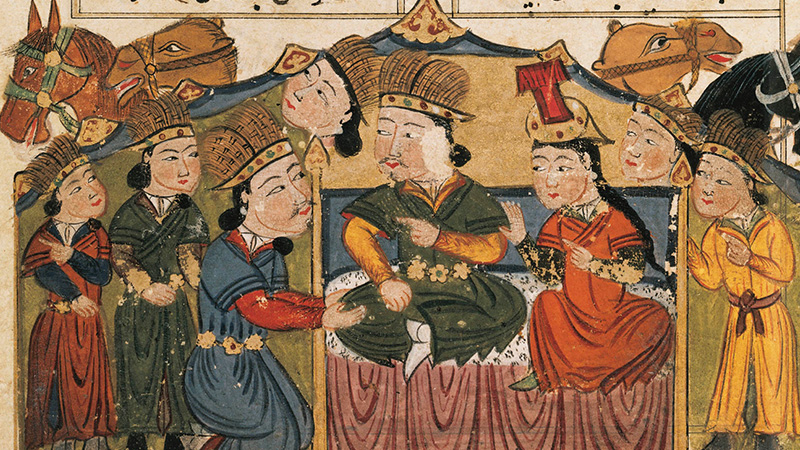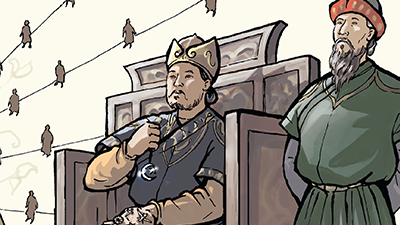The Mongol Empire
Teacher Resources
Driving Question: How did the Mongols manage to build and maintain history’s largest land-based empire?
In one lifetime, the Mongols went from nomadic tribes on the Eurasian steppes to rulers of the largest contiguous land empire in history. Despite its fierce reputation, the Mongol Empire brought stability and security to the Silk Roads. Their legacy influenced other Eurasian empires for centuries to come.
Learning Objectives:
- Assess the Mongols’ impact on networks of exchange.
- Use a graphic biography to support, extend, or challenge the overarching narratives from this time period.
- Use sourcing skills to analyze how the Mongols expanded and ruled their empire.
Vocab Terms:
- confederation
- enslave
- khanate
- Pax Mongolica
- plague
- thwart
Opener: The Mongol Empire
To teach this lesson step, refer to page 2 of the Lesson 6.2 Teaching Guide.
How have other teachers taught students about The Mongols!? Take a look at this thread in the Community Forum.
Building the largest land-based empire in history is no easy feat. In this activity, you’ll think about empire-building tools.
History’s Largest Land Empire
To teach this lesson step, refer to page 3 of the Lesson 6.2 Teaching Guide.
Need to support students reading this graphic bio? Check out the Three-Step Reading for Graphic Biographies tool.
Imagine conquering 17% of Earth and a quarter of all the people on it. Now, imagine controlling it all. That’s exactly what the Mongols did. Find out how, as you explore the Mongol Empire at two different scales.
-
Guiding Questions
-
Before you read
Preview the questions below, and then skim the article. Be sure to look at the section headings and any images.
While you read
Look for answers to these questions:
- Why was the Mongol Empire important?
- What factors contributed to the Mongol Empire’s success?
- How did Mongol rule help expand trade in Afro-Eurasia?
- What role did scholars and technology play in the Mongol Empire?
After you read
Respond to these questions:
- Do you think the Mongols were a positive or negative force for the societies they encountered?
- What evidence from this article supports your opinion? What challenges it?
-
Guiding Questions
-
Before you read
Preview the questions below, and then skim the comic, paying attention to things like prominent colors, shapes, and types of text and fonts. How do you know where to start and in which direction to read? What’s in the gutters (the space between panels)? Who or what is the focus of the comic?
While you read
- Who was Sorqoqtani Beki and what was her relationship to the Mongol royal family?
- What was the cause of Sorqoqtani Beki’s conflict with Oghul-Qaimish?
- How and why did Sorqoqtani Beki win this conflict?
- Batu, Sorqoqtani Beki’s nephew, agreed to support her. What did he get in return, and what was the eventual result?
- How does the artist use art and design to demonstrate the ways in which competition between women—and their support of each other—helped determine Mongol politics?
After you read
Respond to this question: How does this graphic biography of Sorqoqtani Beki support, extend, or challenge what you have learned about the Mongols?
Mongol History
To teach this lesson step, refer to page 5 of the Lesson 6.2 Teaching Guide.
Curious about how other teachers approach sourcing? Look at this Community Forum thread on Sourcing Practice.
A lot of people have written a lot of words about the Mongols. You’ll use the Quick-Sourcing Tool to evaluate some of those words and then delve into the life of a historian working for the Mongols as you work to understand how their empire grew so powerful.
-
Guiding Questions
-
Before you read
Preview the questions below, and then skim the comic, paying attention to things like prominent colors, shapes, and types of text and fonts. How do you know where to start and in which direction to read? What’s in the gutters (the space between panels)? Who or what is the focus of the comic?
While you read
Look for answers to these questions:
- Who was Rashid al-Din?
- What was the difficulty of ruling the Ilkhanate?
- What does the quote from Rashid al-Din’s book, shown in the top panel, tell us?
- How does the artwork in the Jami’ al-Tawarikh demonstrate the diversity of people living in the Ilkhanate?
- How did the artist of this biography try to demonstrate the connections of the Ilkhanate to other regions in the top panel?
After you read
Respond to this question: How does this biography of Rashid al-Din support, extend, or challenge what you have learned about connections and networks in Mongol society?
Closer: The Mongol Empire
To teach this lesson step, refer to page 6 of the Lesson 6.2 Teaching Guide.
You’ve learned that conquering and managing the world’s largest empire was no easy task. In this activity, you’ll reconsider your earlier opinions.
Comparing Pastoral Empires
To teach this lesson step, refer to page 6 of the Lesson 6.2 Teaching Guide.
The Mongols and Comanche each formed large, land-based empires founded on horse power. Watch these two videos and think about how these two empires compare, then practice making claims based on what you’ve learned.
-
Guiding Questions
-
Before you watch
Preview the questions below, and then review the transcript.
While you watch
Look for answers to these questions:
- Which policies did Genghis Khan use to unite the Mongol confederation?
- How did adaptability help the Mongols build their empire? Give at least two examples.
- How did the Mongol Empire affect trade and exchange across Eurasia (and even parts of Africa)?
- How did the Mongols recruit people to work for them? What effects did this have?
- What’s the connection between the Mongols and the Black Death?
After you watch
Respond to these questions: What explains the Mongol’s success? What do you think was the most important factor that allowed the Mongols to conquer and rule such a large empire?
Key Ideas
-
Guiding Questions
-
Before you watch
Preview the questions below, and then review the transcript.
While you watch
Look for answers to these questions:
- What do the Comanche and the Mongols have in common?
- Why were horses so important to the Comanche Empire?
- How did the Spanish colonizers relate to the Comanche?
- What was production and distribution like in Comanche territory?
- How did the Comanche form broader networks and communities with other Indigenous groups?
After you watch
Respond to these questions:
- Is the argument that the Comanche built an empire convincing?
- What other sources or facts support, extend, or challenge this argument?








